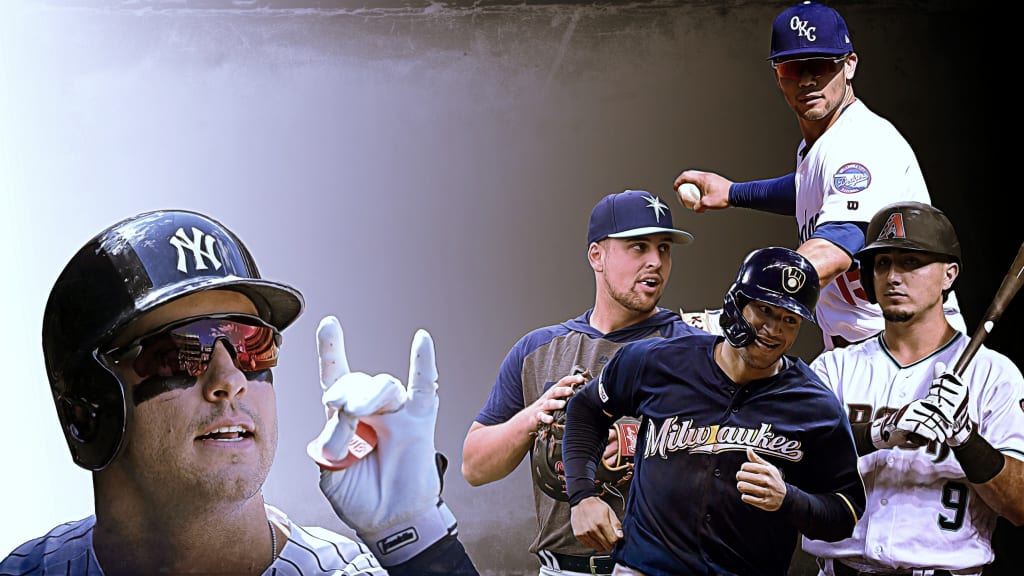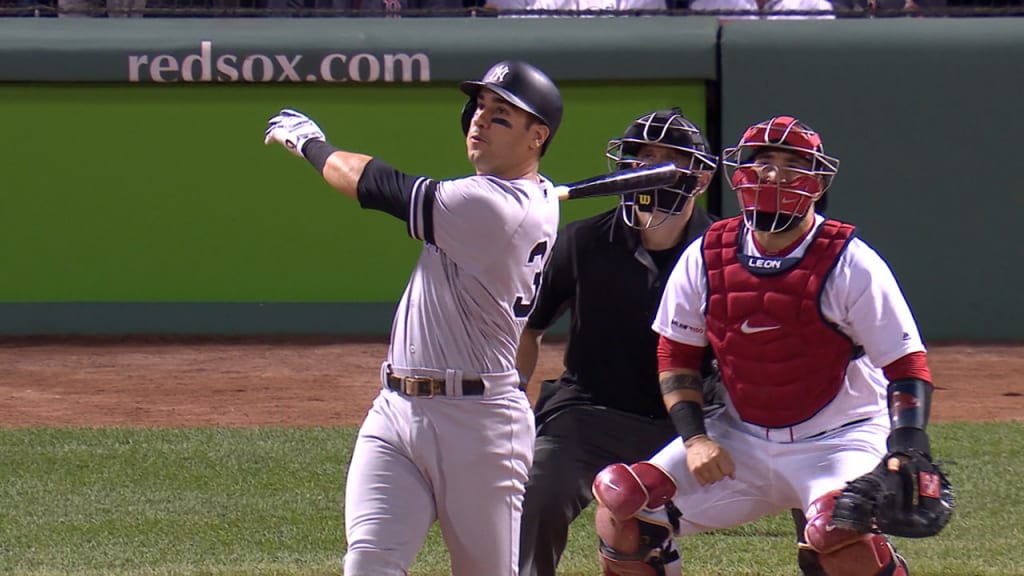Who will be 2020's breakout players?

Mike Tauchman wasn't the only hitter who had a shockingly good breakout season in 2019 (we see you, Mitch Garver, Bryan Reynolds and others). He wasn't even the only Yankee who had an out-of-nowhere strong year, thanks to Gio Urshela, Cameron Maybin and Mike Ford.
But Tauchman may have been the most interesting of any of them, because when he was acquired from the Rockies just a few days before the regular season, it was expressly to serve as depth, given Aaron Hicks' injury and Clint Frazier's demotion to Triple-A. That's not how it played out, of course; despite playing only half a season due to time in the Minors and a season-ending calf strain in early September, Tauchman hit .277/.361/.504 with 13 homers and some of the most elite outfield defense in the game.
All this, after hitting .153/.265/.203 in 69 scattered plate appearances for a weak Colorado offense in 2017-'18. It's the kind of out-of-nowhere, who-even-is-this-guy contribution you could have never seen coming ... unless you could have.
Way back in February, more than a month before Tauchman was traded, FanGraphs's Alex Chamberlain ran an article titled "This is the Definitive Mike Tauchman Hype Post," using a formula based on Minor League numbers to identify Tauchman as a breakout candidate. We'll call that a prescient win.
This browser does not support the video element.
There's a flaw there, of course, which is the time-honored chestnut: You can't scout the stat line. That is, there's a lot more that goes into Minor League scouting than numbers. A pitcher's poor line might be explained by a mandate to work on improving his curveball, a priority over getting outs. An older college hitter might pound Low A pitching, providing evidence he shouldn't be in that league. And if you think Coors Field brings some extraordinary hitting environments to the Majors, wait until you see what what some of the western Minor League parks like Lancaster, El Paso and Amarillo do.
It's sound advice, and a fair warning. And yet ... Tauchman was identified as a possible breakout, even despite his high-offense Triple-A Albuquerque home. St. Louis reliever Giovanny Gallegos consistently showed elite Minor League strikeout rates in 2016-'18 despite what seemed like a lack of eye-popping stuff and limited appearances on top prospect lists ... and then he became one of the better relievers in the Majors in 2019, somewhat unexpectedly. It's true that you can't "scout the stat line," and yet it seems like you shouldn't entirely ignore it, either.
So we thought to ourselves, what if we reverse-engineer the method that popped Tauchman, make some slight tweaks, and see if we can dsicern who might be 2020's possible breakouts? This is somewhat more for entertainment than serious analysis, because we don't have access to important Minor League data like exit velocity or launch angle, and we have never seen any of these players play in person. But as a way of surfacing some interesting names knowing that there's a maybe 1% chance they turn into something, it's a fun exercise.
So, we looked for players who combined power with plate discipline, similar but not identical to the original study, with these requirements:
• Minimum 400 plate appearances in 2019 (Double-A/Triple-A only)
• A slugging percentage of at least .500
• A walk rate at least 80% as much as strikeout rate
• Younger than 30 years old
There's a speed/positional component we'll get into in a second, as well as a "hype" component, but that's a good place to start. It gave us four names for 2019. But before we get to those, let's see if this worked in the past. From 2010-'18, we found a dozen seasons (from 11 players, one of whom did it twice) that would have qualified. They are:
• Mike Tauchman, 2018
• Rhys Hoskins, 2017
• Daniel Vogelbach, 2016
• Max Kepler, 2015
• Mookie Betts, 2014
• Allan Dykstra, 2014 and 2013
• Paul Goldschmidt, 2011
• Collin Cowgill, 2011
• David Cooper, 2011
• James Darnell, 2011
• Jermaine Mitchell, 2011
Right away, there's some interesting names on that list. Betts and Goldschmidt are two of the bigger stars in the game. Kepler had a breakout age-26 season in 2019, with 36 homers, and Vogelbach's own age-26 season yielded 30 homers and 92 walks. Hoskins has hit 81 homers in 2 1/2 seasons as one of the game's better power sources. Of the 10 players aside from Tauchman, half of them have found above-average big league success.
So what happened to the other five? In a lot of cases, injury. Darnell's career was sidetracked before it got started by multiple shoulder surgeries. Cooper underwent what was referred to as "rare spinal surgery." Dykstra broke his wrist and fibula in the Minors, and received only 38 Major League plate appearances, in part because he was a below-average defender limited to first base. Mitchell had knee surgery right after his breakout season and never received 500 plate appearances in a season again. Cowgill carved out some time as a backup outfielder, but his inclusion at all probably was about his home ballpark, as he slugged .639 in Reno in 2011 and .481 on the road.
Either way, we should never expect a 100% success rate or close to it, given the relatively surface-level nature of what we're doing. Plus, if we're really trying to find another Tauchman, we should just be looking for speedy outfielders -- he has seven seasons of double-digit steals -- which would knock out 1B/DH types like Hoskins, Vogelbach, Goldschmidt, Cooper and Dykstra.
Still, doing this finds us some big Major League names and a few Minor Leaguers who never had a chance due to injury. Who are our four names from 2019 to keep an eye out for next season?
Let's split them in half. The first two qualify for most of our requirements, but fall short in some ways.
This browser does not support the video element.
Trent Grisham, OF, Brewers (turned 23 on Nov. 1)
Yes, the guy you only know from "making the horrible eighth-inning error in the Wild Card Game that might have started the Nationals on their run to a title and in the process changed all of baseball history." That's a lot to put on him, and it's unfair, but it's what we've got.
Grisham got some scattered playing time in August, then more after Christian Yelich was injured in early September. He was OK, posting a .231/.328/.410 line that was 10% below the league average, but then again, remember how little Tauchman did with the Rockies.
In the Minors, however, Grisham hit .300/.407/.603 in 441 plate appearances at two levels, showing an excellent eye by drawing 67 walks against only 72 strikeouts. He did slug better at home (.650) than on the road (.543), but both were good, and either way, this isn't a park thing. His Triple-A park in San Antonio was only slightly hitter-friendly, while his Double-A park in Biloxi was incredibly pitcher-friendly, more so than 90% of the rest of the Minors.
Why he's not a perfect fit: Sure, he's an outfielder with speed, swiping 38 bases in 2017. But he was also the 15th overall pick in 2015, ahead of other first rounders like Walker Buehler and Mike Soroka. He's made a few Top 100 lists, though not in the last two seasons, but he's still only just now 23 years old. Does that count as "out of nowhere"? Arguable.
Nate Lowe, 1B, Rays (turns 25 next July)
A 13th-round pick of Tampa Bay in 2016 -- that would be 12 rounds after his more highly touted brother Josh was the 13th overall pick by the same Rays -- Lowe had a breakout 2018 at three levels, hitting .330/.416/.568 with 27 homers, vaulting him onto the prospect radar. If we'd dropped our requirements from "walk rate 80% of strikeout rate" to "walk rate 75% of strikeout rate," he'd have qualified in 2018. As it was, he ever so barely missed, but made it onto the list in 2019. In 50 games for the Rays, he hit a league-average .263/.325/.454.
Why he's not a perfect fit: He's almost exclusively a first baseman, with handful of pro games at third base, and he has no speed to speak of. Plus, he was regularly a Baseball America Top 100 prospect before his recall, and he's likely already going to fit prominently into Tampa Bay's 2020 plans.
The second two, however? These are the two. These are the deep cuts.
Connor Joe, OF/UTIL, Dodgers (turns 28 next August)
Fine, Joe was a first-round pick of the Pirates back in 2014, so you might think he shouldn't qualify for "out of nowhere" status. But dig his career path ever since: Traded to the Braves in August 2017 for Sean Rodriguez, traded two weeks later to the Dodgers for international slot money, selected in the Rule 5 Draft by the Reds headed into 2019, traded to the Giants on March 21, part of the unlikeliest Opening Day outfield you can ever remember, then returned to the Dodgers after all of 16 big league plate appearances. Phew.
OK, so that's a lot. A lot! But through it all, Joe has kept on hitting, posting a career Minor League OBP of .377. In 2018, he slugged .527 and followed that up with .503 in 2019, when he had 72 walks and 81 strikeouts. There are external factors here, as all of Triple-A added power in 2019 while using the Major League ball, and his home park in Oklahoma City (Triple-A) was very hitter-friendly. That wasn't true in Double-A Tulsa, however, which is a neutral park.
Joe can't really run, and he's not going to be the defender Tauchman is. This is possibly not a perfect comp. But Joe made the list, and the Giants saw enough in him to have him start Opening Day. There might be something here.
This browser does not support the video element.
Josh Rojas, UT, D-backs (turns 26 next June)
Rojas was a 26th-round Astros pick in 2017, and he was part of the trade that sent Zack Greinke out of Arizona this past summer. He didn't exactly light it up with the D-backs -- .217/.312/.312 in 157 plate appearances -- but he'd hit .332/.418/.606 for three Minor League teams. That did all come at some high-offense parks, but he did slug much better on the road (.676) than he did at home (.538); either way, the most impressive part was his 70/57 K/BB.
He's also got some speed, having swiped 38 bags in 2018 and 33 more in 2019, and he's never appeared on a notable top prospect list that we can find. While he's probably not quite as good a fielder as Tauchman, he also made starts at first, second, third, short, left, and right in 2019, giving him a different kind of defensive value.
Will any of these names pan out into stars? Probably not. It might be more likely none of them have lengthy careers. But if we're trying to find more players like Tauchman, the success rate ought to be pretty low. After all, those kind of breakouts just don't happen that often.
This browser does not support the video element.
